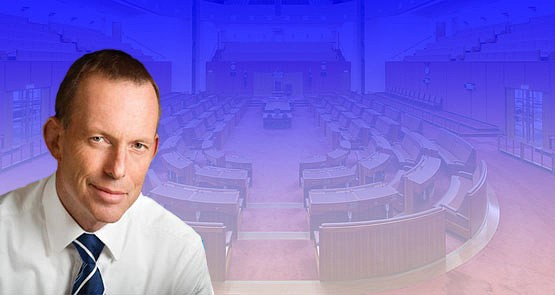
A Coalition whitewash at this year’s federal election could still deliver Opposition Leader Tony Abbott control of both houses of parliament. A Crikey analysis of the likely impact of yesterday’s state-by-state April-June Newspoll breakdown on the Senate vote shows an outside possibility of a John Howard-style Senate majority, which would enable clear passage for repealing the carbon and mining taxes and the ditching of the Gonski education reforms when new senators take their seats on July 1 next year.
But even if it can’t grab the main prize, which would probably require the Coalition to win an unprecedented 4 senate seats in NSW, it still should be able to govern effectively with the support of right-leaning minor parties.
The trend towards an Abbott victory of epic proportions on election day now seems irreversible. According to Poll Bludger’s BludgerTrack, the Coalition’s two-party preferred vote is around 60% in Queensland and Western Australia and close to 58% in South Australia and New South Wales. On these numbers Labor stands to lose 31 lower-house seats.
While the House of Representatives gets the attention, predicting the Senate is trickier, mostly due to the vagaraies of each state race, margins of error and the possibility that a low-polling independent or micro party will get a dream Steve Fielding-style preference run. There are a range of possibilities without requiring any significant change in the vote.
It’s best to divide the Senate vote into Left and Right: Labor and the Greens on one side and the Liberals, Nationals, WA Nationals, the Liberal National Party, and microparties like the DLP, the CDP, Katter’s Australian Party and Family First on the other. In the current Parliament, Nick Xenophon has a foot in each camp. With six Senate spots up for grabs at each election, the vast majority of races have traditionally split 3-3 and no single party has ever won 4 Senate seats.
On that basis, the current Senate is divided 40 Left (31 Labor, nine Greens) to 35 Right (24 Liberal, six LNP, three Nationals, one CLP, one DLP). Assuming the Coalition will hold the seats it won in 2007, it needs a gain of five senators on September 14 to govern in its own right with a working majority of 39 of 76 senators. Anything less and it will require the support of Right-leaning crossbenchers, including the DLP’s John Madigan (although 38 would still stop Labor and the Greens setting up hostile committees).
A quota for a seat in the Senate is 14.29%. For the first time in this Parliament, the Coalition is polling above three Senate quotas (42.9%) in all states on Newspoll. However, as a general rule, at least 2-3 percentage points should be lopped off those lower house numbers, while the Greens and minor parties’ primaries should be at least one point higher. In South Australia, Xenophon’s presence means the major party vote will likely dip even lower. The Family First vote usually stays the same across both houses.
Way back in September 2011, ABC guru Antony Green categorised the steps necessary for the Coalition to secure a Senate majority, state-by-state, in order of likelihood. We’ll follow his lead here …
In Tasmania, the two ALP seats and two Liberal seats up for re-election are considered safe, as is the Greens’ seat held by Peter Whish-Wilson. The real action here will be the third ALP spot currently held by Lin Thorp. Considering the recent collapse in Labor’s and the Greens’ primary votes (and despite Newspoll’s sample being too small), the most likely scenario now is three Liberal, two Labor and one Green, as local psephologist Kevin Bonham explained earlier this month. That’s one extra Coalition seat.
“In summary, the Coalition looks set to gain either three (Tasmania, SA, WA), four (Tasmania, SA, WA and Queensland) or five (Tasmania, SA, WA, Queensland and NSW) Senate seats.”
In South Australia, Newspoll shows the Coalition primary on 44% (up four points since the 2010 election), Labor on 30% (down 11 points) and the Greens on 10% (down two points). Being the home of Xenophon, “others” is on 16%. In 2007, the state elected two Liberals, two Labor, a Green and Xenophon. According to poll watcher Ben Raue, the likelihood of the Greens’ spot held by Sarah Hanson-Young being snaffled by the Right is more likely if the Coalition can extend its primary in the Senate to around three quotas or 42.9%. Likely result? Three Liberal, two Labor and one Xenophon — a gain of one to the Coalition.
In Western Australia, Newspoll shows the Coalition’s primary vote is on a massive 55% (up 4 .4 points from 2010), Labor is on a scarcely believable 25% and the Greens are on 11 (down 2.1). The WA Nationals are running a separate ticket and have enlisted high-profile former West Coast Eagles goal sneak David Wirrpanda as its candidate. The separate ticket is important — in 2004 when the “Coalition” won four in Queensland, the Nationals ran a separate ticket, elevating the combined vote. These numbers, notwithstanding falls in the Newspoll numbers when translated to the Senate (-4% in 2010), put second ALP Senator Louise Pratt in the killing zone. Even if she manages to get up it won’t make a difference to a Coalition majority. A strong possibility now: four Coalition (three Liberals plus one WA National), one Labor and one Green — another one-seat gain for the Coalition.
In Queensland, Labor’s primary vote, according to yesterday’s Newspoll, is the second-lowest in the country behind WA at 29% (down 4.6 points), with the Coalition on 46% (down 1.4 points) and the Greens’ vote dipping to 8%. The wildcard here is the KAP, with “others” more than doubling to 17% from 8.1% in 2010. This scenario would likely deliver three LNP senators and two Labor, with the final seat a raffle between Katter’s country music candidate James Blundell and the Greens’ Adam Stone. Or, as an outside possibility, four LNP, one Labor and one Katter. But there should be enough for two Left seats — some kind of 4/2 Right/Left split would seem the most likely outcome, a gain of one for the Right but probably not the LNP.
In Victoria, Liberal (43%) and Labor (37%) will likely re-elect three and two senators respectively, with the last spot likely to go to the Greens’ Janet Rice (12%), who’ll likely benefit from Labor’s substantial surplus. There is a slim possibility Julian Assange could snaffle the last spot for his WikiLeaks Party, but that is highly unlikely without a miraculous preference run. There’s no way Labor will do “another Fielding” and preference a minor Right party above the Greens this time round. The mostly likely result mirrors Tasmania — three Liberal, two Labor and one Green — a continuation of the traditional 3/3 Right/Left split.
In NSW, things get more complex. In 2010, Labor snagged two seats, the Greens one, the Liberals two and the Nationals one after a 3/3 Labor-Liberal split in 2007. This time around, the Coalition will almost certainly elect three senators and the ALP two. But feeding in yesterday’s extraordinary Newspoll result that had the Coalition on a primary vote of 48%, Labor on 30% and the Greens on 9%, we’re looking at a swing of over 6% away from the Left that on Raue’s estimate would lead to either four Coalition and two Labor, or, more likely, three Coalition, one minor Right party (probably the Shooters and Fishers Party, the CDP or KAP) and two Labor. Either way, the Greens’ Cate Faehrmann would miss out. Let’s stick with a 4/2 Right/Left split for now, a gain for the Right of one.
Lastly the territories, where two senators mean the quota is 33.3%. The Northern Territory will almost certainly split 1-1 Labor-CLP, as it has done at every election since senators were first elected in 1975. In the ACT, despite high-profile Greens candidate Simon Sheikh’s run — a strategy reliant on Labor’s surplus over quota to vault him over the Liberals’ Zed Seselja — it is more likely the Liberals will keep their vote above quota, meaning Labor’s surplus will be irrelevant. Seselja will replace Gary Humphries at the first sitting after the election, while Labor’s Kate Lundy will stay put — splitting 1-1 Labor/Liberal.
In summary, the Coalition looks set to gain either three (Tasmania, SA, WA), four (Tasmania, SA, WA and Queensland) or five (Tasmania, SA, WA, Queensland and NSW) Senate seats. In the first two scenarios, a Katter or minor Right crossbenchers would likely still be on hand to roll back the carbon tax and deny the Greens the balance of power. In the third, an unprecedented four single party seats would have to be won in NSW. But it’s that kind of year — and there’s no prizes for guessing which outcome Prime Minister Tony Abbott would prefer.








So the greens would lose two seats? Surprising to think that all the anti-ALP sentiment out there would only swing to the right…
Gerry, exactly. Disillusioned ex-Labor supporters aren’t only on the Right…
You may need to rejig those figures after tonight’s ALP Leadership ballot
I give Rudd’s poll boost about 24 hours. Labor’s idiocy guarantees a wipe out. I honestly couldn’t make a good case for voting for this spineless twits. The country deserves abbott in all his glory with a senate majority.
What happens to the numbers if we have a double dissolution and the Senate quota drops to 7.69%?